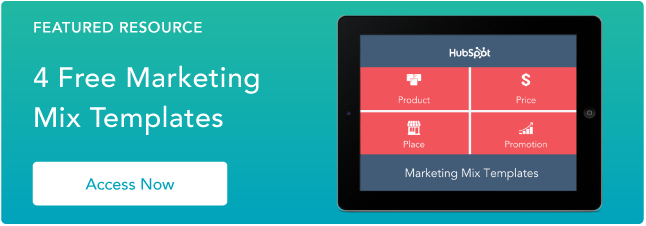One of the first things you're taught in your Introduction to Marketing class is that marketing can be best explained using the marketing mix – also known as the four Ps.
They are – and say 'em with me because if you took that class, you know these four words by heart:
- Product
- Price
- Place
- Promotion
→ Free Resource: 4 Marketing Mix Templates [Access Now]
Still, there's an undeniable benefit of marketing teams organizing their work into the marketing mix framework.
When you stray too far away from the four P's, it can be easy to lose focus on your purpose as a marketer.
Marketing truly is about teams and individuals working together to promote a product in the right place at the right price point. Efforts beyond this scope are essential, but they do all stem off of this foundation of the marketing mix.
.png)
Free Marketing Mix Templates
Map out your marketing mix with these free templates
- Product
- Price
- Place
- Promotion
Download Free
All fields are required.
.png)
Here, we're going to dive into what a marketing mix is and how to develop a successful marketing mix strategy for your own company.
What is a marketing mix?
The marketing mix refers to the actions a company takes to market its product(s) and/or service(s). Typically, it acts as a framework for breaking down the four key components of marketing — product, price, place, and promotion.
The marketing mix helps companies organize their marketing initiatives by task and department for more process-driven and impactful marketing campaigns.
This framework has roots dating back to the 1940s and has been evolving ever since. While some elements have been added or tweaked over the years – most notably for the modern digital age – the core elements of the marketing mix (i.e. the four P's) have remained consistent for decades.
Featured Resource: Marketing Mix Templates
Need a way to visualize your marketing mix to share it with your employees or investors? Use these four marketing mix templates to organize your initiatives and activities by the right section. Click here to download them now.
Marketing Mix Elements
When perfected and synchronized, the core elements of a marketing mix provide a well-rounded approach to marketing strategy.
1. Product
Product refers to what your business is selling – product(s), service(s), or both. The bulk of the work in this element is typically done by product marketers or managers.
Nailing the product element of the marketing mix means doing extensive research and development, understanding the need for the product, developing a product launch plan and timeline, and educating customers and employees – especially salespeople – on the product's purpose.
2. Price
Price refers to the price point at which you'll sell your product(s)/service(s) to consumers. Arriving on this dollar amount requires consideration of multiple pricing strategies, analysis of similarly priced products in your market, and insights from consumers through surveys and focus groups.
Price speaks to positioning in the market, the speed at which you want to penetrate your market, and your company's revenue goals and profit margin.
3. Place
In the marketing mix, place refers to where your product or service will be sold. For tangible products, this will include physical locations such as your own store, or a retailer where your product will be resold.
It can also include the other methods where your products can be purchased, like online or over the phone.
4. Promotion
Promotional activities are those that make your target market aware and excited about what you're selling.
While this does include paid initiatives like commercials and advertising, promotion also entails organic initiatives like word-of-mouth marketing, content marketing, and public relations.
Other Elements
While the marketing mix can often be simplified down to the 4 P's, the expansion of the scope of marketing in recent years has resulted in more P's added to the list.
For example, Smart Insights includes the following elements in its marketing mix definition:
- Process, or the large internal initiatives taken to support a product launch, such as including salespeople in goal setting.
- People, which can refer to your buyer, market, and target audience, or your internal team responsible for a launch.
- Partners, or who you'll be working with outside of your company, such as distributors or co-marketing partners.
Some of the other P's can include:
- Payment, or how transactions will be held and processed.
- Physical evidence, or anything tangible pertaining to your product or service, like any materials needed to complete your service or deliver your product.
- Packaging, or anything pertaining to the physicality of your product, like how it looks or how it's packaged.
These other marketing mix elements should be utilized as you see fit for your projects. However, every good marketing mix should rely on a thorough exploration of those first 4 Ps.
Marketing Mix Examples from Real Businesses
Product
Mercaris
Fintech companies are everywhere, but how many of them focus on organic and non-GMO agriculture?
As sustainable agriculture becomes more top of mind, brands like Mercaris help support agriculture companies looking to stay ahead in the market. Beyond delivering a service, the company identified a niche and launched a business with few direct competitors.
They offer a monthly subscription-based service that arms agricultural companies with the market intelligence needed to compete in the space. This includes detailed reports on food production, commodity prices, and market shifts.
Noirbnb
Not long after Airbnb launched, users filed complaints of racism from their hosts and expressed reluctance to use the platform's services. The company implemented measures to appease these concerns. However, it brought attention to an important issue.
It's this uncertainty that allowed Noirbnb to enter the market. The brand tapped into people of color's desire to feel safe and welcomed in their temporary home while traveling – then, they used it as their unique selling position (USP).
The brand even plays on Airbnb's name – which is now a household one – to indicate that they offer a similar service that's been adapted to cater to travelers of color.
.png)
Free Marketing Mix Templates
Map out your marketing mix with these free templates
- Product
- Price
- Place
- Promotion
Download Free
All fields are required.
.png)
Price
Warby Parker
This online retailer of prescription eyeglasses and sunglasses is known for its stylish yet affordable glasses. Warby Parker 's pricing, which starts at $95, undercuts many of its competitors, making it a popular go-to for consumers.
The brand's pricing strategy is based on public perception. In interviews, the founders revealed that originally, they were going to price their frames as low as $45. However, after considering how low prices for items like glasses can be perceived as low quality, they doubled the price to settle at a number that was still competitive.
A brand's pricing strategy can have an important role in how it's perceived in the market. So, it's important to consider what that perception is and if it's the one you want to put out there.
Canva
When Canva entered the market, it was every small business owner's dream. You could design any marketing material you wanted for FREE, what more could you ask for?
Eventually, the brand introduced premium versions of its platform. Catering to businesses ranging from small to enterprise-level, they added features like high-quality stock visuals, social media publishing tools, marketing campaign management, and large cloud storage.
Placement
Hu
Hu, short for "Get Back to Human," is a dessert company that specializes in making organic, paleo chocolate bars free of the junk ingredients we find in big-name products.
The brand has made its products available from multiple major retailers, including Walmart, Target, and Whole Foods. They also have a virtual storefront on Amazon. If stock ever runs out there, you can always purchase their products through their website.
Hu has made its product accessible through multiple channels, maximizing its earning potential while expanding its brand awareness.
Promotion
The Lip Bar
Vegan beauty brand The Lip Bar leverages influencers and celebrities to promote its products and increase its brand awareness. Recently, the brand partnered with beauty influencer Raye Boyce to announce its expansion into Walmart stores and its nine latest products.
The Lip Bar places women of color at the center of its products and collaborating with a Black influencer known for her love of lipsticks is in perfect alignment with the brand's identity.
Beyond a robust social media presence, the company also has a blog on its website with content that appeals to audiences across the buyer's journey.
Avant-Garde Vegan
Some brands launch a product then promote, while others promote then launch.
Avant-Garde Vegan, an online brand created by UK-based chef Gaz Oakley, grew his business on social media – namely YouTube. Oakley gained popularity posting recipes for healthy, vegan dishes and soon became a go-to resource for new and established vegan consumers.
Eventually, Oakley released his first product, a cookbook. Now the brand sells both cookbooks as well as merchandise.
The reason why this strategy works particularly well is that it focuses on adding value instead of selling. Oakley gained his audience's trust and loyalty through consistent and quality posts on social media.
Once he introduced a product, many of his followers were ready to make a purchase. It's a long-term strategy that can have a big payoff if executed well.
How to Develop a Marketing Mix Strategy
Because the marketing mix incorporates elements from across your department – and even your company – it's imperative to establish a marketing mix strategy for each product you launch, or for your company as a whole. For a fully fleshed-out marketing mix, follow these steps.
1. Engage in market research and product development.
The success of your marketing work is first and foremost contingent on your product. Make sure it's well developed and your team can speak to its benefits and the story behind it.
Best practices in this step include:
- Engaging in market research to understand your buyers' needs.
- Speaking to your current customers to uncover their pain points and see which needs to address in your current product or service line.
- Monitoring industry trends to identify a potential demand in your market.
- Examining the competition.
- Collaborating with your product team during product development to ensure it meets your buyer personas' needs.
- Having your product tested by current customers to see how they're using the product or service and if it's actually solving for their problems.
Taking these actions ensures you're making every effort to understand and solve for your customer, providing a solid foundation for your product to launch successfully.
Featured Tool: Market Research Kit. To make your R&D more impactful, use these free market research templates so you can better understand your customers and competitors.
2. Determine your pricing model.
A lot goes into choosing a price point – so much so that we wrote an entire guide to pricing strategies.
Luckily, you'll be able to refer to much of the work done in the previous section. Thanks to your understanding of your market through research, you'll have answered most of the necessary questions in this section. You'll also need to take your costs into account so you can maximize unit sales and profit.
During this stage, make sure you do the following.
- Speak to customers (or refer to previously completed market research) to determine the ideal selling price.
- Work with the product team to ensure the product can be developed in a cost-effective manner that would ensure profitability at your target price point.
- Meet with financial experts to determine aggressive yet realistic sales forecasts to contribute to the company's bottom line.
- Collaborate with your sales team to determine discounting strategies.
- Determine how you'll adjust price and revenue forecasts when selling through resellers.
Lastly, don't forget to factor in the perceived value by the customer. Even if your product or service doesn't cost a significant amount to make, you'll be able to mark up your product more if you face little competition and provide an irreplaceable benefit to your customers.
Featured Tool: Pricing Strategy Calculator. If you need help selecting your pricing model, use this template to compare different pricing strategies and see which will yield your company the most profit and revenue based on your forecasts.
3. Choose your distribution channels.
The "place" part of the marketing mix answers where your product will be sold. Keep in mind, this can be any combination of your store, a distributor's store, or online. You'll want to address the following points before moving onto the promotion stage:
- Determine if your product will fare best in your physical location, a store of another retailer, on your website, on another company's website, or some combination of these locations.
- Think about geographic location – make sure your supply meets regional demand, and plan for whether or not what you're selling will be available in a certain city, a state, the country, or worldwide.
- Come to an agreement with retailers and resellers on margins, markups, and manufacturer suggested retail prices (MSRP).
- Figure out how many salespeople will be needed to ensure you meet your goals.
- Set goals for retail, third-party sellers, since you may be sharing shelf space or search results with a competitor or two.
4. Select your promotion tactics.
Finally, it's time to promote your product. While this is probably the element most associated with marketing, it's crucial that this element be completed last, because you need the foundation of product, price, and place before determining promotion tactics.
Think about it – shouldn't you know what you're promoting, why you're promoting it, and where it's available before actually promoting it? It's tempting to jump right to this step, but your promotion will be much better off if it's done after everything else in the marketing mix.
Once you do have that understanding, consider the following promotional channels and choose the one(s) that makes the most sense for your product, its buyers, and its price point:
- Content marketing efforts, such as blogging, content creation, and building a website.
- Public relations and working with affiliates and/or influencers.
- Social media marketing – both organic and paid – on channels such as LinkedIn, Facebook, and Instagram.
- Search engine ads on sites like Google and Bing.
- Ads to air on video streaming sites like YouTube, or on TV.
- Event marketing, including attending industry events or hosting your own event.
- Customer marketing and utilizing referrals.
- And more – There are countless promotional ideas you can use to spread the word on your product, service, or business.
Featured Tool: Marketing Plan Template. If your promotional tactics are multi-faceted enough, consider documenting your plans in this customizable template.
.png)
Free Marketing Mix Templates
Map out your marketing mix with these free templates
- Product
- Price
- Place
- Promotion
Download Free
All fields are required.
.png)
Marketing Mix Templates
Every company's marketing mix is different, placing emphasis on certain factors over others.
Some businesses use their marketing mix for a single product, while others adopt a company-wide marketing mix. However, good marketing mixes should tie in all the elements without neglecting one.
All elements of the marketing mix are important, so don't be quick to overlook any of them, and find ways for different elements of the mix to overlap and share goals.
With so many activities happening to support a single initiative, it's helpful to organize everything in a single template for easy reference. Here are a few examples of marketing mix templates your marketing department can use, in addition to when they might make sense to reference.
1. Simple Marketing Mix Template
This template is a great starter for organizing a marketing mix. It's ideal for one product and for the marketing mix's maker to get an understanding of all the elements involved in the marketing of a product.
2. Company Marketing Mix Template
For a marketing mix that applies company-wide, this template is a perfect fit. You can outline the initiatives that apply to most or all of the products and/or services in your suite.
3. Structured Marketing Mix Template
For when you need to get right to the point with a more organized, actionable visualization, use this structured, bulleted template for quick reference and clarification.
4. Production Marketing Mix Template
Finally, a production marketing mix template is best utilized for internal reference. This template answers questions on the go-to-market efforts for products and services that you're selling.
Mix It All Together
Whether you're a student just learning to understand everything that marketing entails or a CMO hoping to clearly convey the work that your team is doing to your fellow employees, the marketing mix framework is an essential tool to help you get the job done.
Don't forget – if you need to organize your marketing initiatives into a central location, try using HubSpot's Marketing Mix Templates to document your activities in one place.
.png?width=112&height=112&name=Image%20Hackathon%20%E2%80%93%20Horizontal%20(11).png)









![Marketing Budget: How Much Should Your Team Spend in 2025? [By Industry]](https://53.fs1.hubspotusercontent-na1.net/hubfs/53/how%20to%20spend%20your%20marketing%20budget_featured.webp)
![How to Manage Your Entire Marketing Budget [Free Budget Planner Templates]](https://53.fs1.hubspotusercontent-na1.net/hubfs/53/adbudget.webp)





